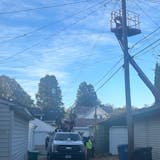The voice that tells you how to get where you want to go in your car may soon be saying, "Slow down in this snow, OK?"
Not in those words, exactly, but researchers are working on ways to collect road, weather, and even vehicle behavior data from moving vehicles, then distribute it immediately to help drivers stay out of trouble.
"On a lot of cars today, you're maybe getting an air temperature reading on the dashboard, but only you get that," said Sheldon Drobot, weather systems and assessment program manager at the National Center for Atmospheric Research in Boulder, Colo. "Wouldn't it be interesting if we could share that with the weather service, and get a road forecast, and tell people how to get where they need to go more safely, faster and with less impact on the environment?"
Drobot is in the third year of an effort sponsored by the Federal Highway Administration to develop individualized information systems for drivers that could reduce the risks on everything from cross-country road trips to crosstown errands. It's known as "decision support."
This winter, the Minnesota Department of Transportation (MnDOT) is involved in the research, equipping about 80 snowplows with sensors designed to help plow drivers better gauge road conditions and determine what kind of snow- and ice-clearing chemicals might work best in their location, and how much to use.
"Improved consistency should give us better safety" while also cutting costs, said Curtis Pape, road weather information systems coordinator for MnDOT.
Vehicle computers already can track whether the windshield wipers are on, whether the anti-lock brakes have been engaged, steering patterns and, of course, speed, Drobot noted.
Transmitting that information to a central system, where it could be combined with weather radar readings, pavement temperature and other atmospheric data from roadside sensors is the first step in developing an on-the-road hazard-alert system.

